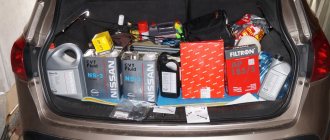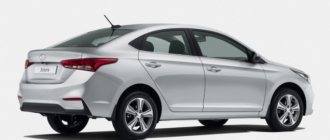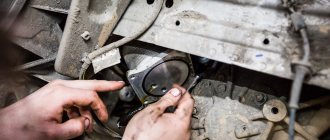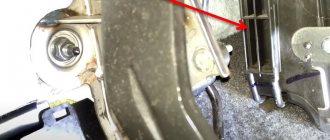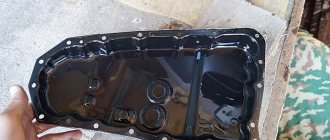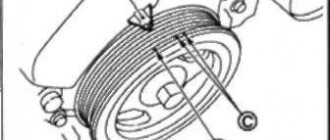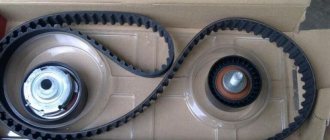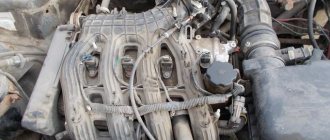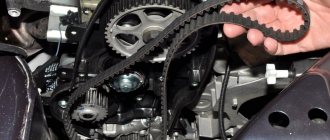Popular in the world and in Russia, in particular, the Nissan Qashqai crossover has been produced from 2006 to the present day. There are four varieties of this model: Nissan Qashqai J10 1st generation (09.2006-02.2010), Nissan Qashqai J10 1st generation restyling (03.2010-11.2013), Nissan Qashqai J11 2nd generation (11.2013-12.2019), Nissan Qashqai J11 2nd generation restyling (03.2017- present time). They are equipped with 1.2, 1.6, 2 liter petrol engines and 1.5 and 2 liter diesel engines. In terms of independent maintenance, this machine is quite complex, but with some experience you can handle it on your own. For example, change the timing belt yourself.
Engine Nissan Qashqai 2.0 timing device, technical specifications
The Nissan Qashqai 2.0 liter gasoline engine of the MR20DE series can be found not only on Nissan models, but also on Renault cars under the M4R symbol. Aspirated gasoline power varies from 133 to 147 hp. depending on settings. The motor is quite modern, its development was completed in 2005. The engine is assembled mainly in Japan.
Belt: pros and cons
- The belt is elastic and quiet, absorbs vibrations well from torsion, and does not require lubrication;
- Its faults can be easily diagnosed and eliminated without fundamental disassembly of the engine blocks. It can be changed according to the staffing schedule, when critical resource expenditure is still relatively far away.
The main disadvantage is vulnerability and dependence on external natural conditions, as well as technical ones: ingress of lubricant, for example.
If the belt breaks, the camshaft is no longer in sync with the crankshaft and the pistons hit the valves when they are open. Result: repair of engine compartment valves and many more troubles, including capital.
Design of the Qashqai 2.0 liter engine.
The in-line 4-cylinder 16-valve gasoline engine has an aluminum cylinder block. The timing chain drive is equipped with a variable valve timing system with a phase shifter on the intake camshaft. There are no hydraulic compensators in the cylinder head. The valves must be adjusted manually by selecting pushers-washers of different thicknesses.
Nissan Qashqai 2.0 engine cylinder head
The Nissan Qashqai block head is made of aluminum alloy. Two camshafts rotate in the bearing housing, which press their cams directly onto the valves through special pushers. The camshafts are not secured with separate covers, but with a common pastel. Spark plug wells have very thin walls; excessive force when tightening spark plugs leads to cracks in the cylinder head. The mechanism for changing the valve timing on the intake shaft is implemented using a hydraulic system. An increase in pressure causes an increase in the deviation of the camshaft from the nominal position relative to the valve axes. The oil pressure level is regulated by a solenoid valve controlled by the electronics of the Nissan Qashqai engine.
Engines for second generation cars
The second generation Nissans used improved MR20DE internal combustion engines. They received the name MR20DD (that is, only the last letter was changed). During the improvement, the engine was supplemented with a variable valve timing system on two shafts, and an intake manifold with direct injection and variable length was added. This made it possible to increase power to 144 hp. s., torque - up to 200 Nm. This is the maximum torque achieved at a rotation speed of 4400 rpm.
At the same time, the engine remained economical - its consumption was 5-8.5 liters per 100 km. In addition to the Nissan Qashqai, the installation was installed on other cars:
- Minivans 4-5 generations (Serena).
- 3rd generation SUVs - X-Trail.
Now this engine is installed on restyled Nissan Qashqai models.
Another gasoline engine installed on second-generation Nissans is the H5FT with a power of 115 hp. With. and a cylinder volume of 1.2 liters.
The maximum torque (205 Nm) is achieved at 2000 rpm, which allows you to “rip” at the start and quickly develop high speeds. This is an extremely economical internal combustion engine with consumption of 5.6-6.2 liters per 100 km. The small volume of the cylinders is compensated by the presence of a supercharger (turbine). The engine itself received a timing chain, an aluminum cylinder block (to reduce weight), direct injection and a variable valve timing system.
A special feature of this internal combustion engine is a supercharger with a low cylinder volume. Therefore, after the start, in order to confidently switch to second gear, it must be revved up to 4000 rpm. This moment is extremely unpleasant for many owners, but you can get used to it.
The latest engine installed on the 2nd generation Nissan Qashqai is the R9M with a volume of 1.6 liters. This is a diesel power plant with a supercharger with a capacity of 130-160 hp. With. and a torque of 380 Nm (at 1750 rpm).
The engine is also installed on Renault cars. Like many other Nissan power plants, it uses a timing chain (the chain is designed to last the entire service life of the engine, although it stretches after 300 thousand kilometers). The variable geometry turbine provides an additional 1.5 bar of boost, which provides the specified power.
The engine does not have serious shortcomings or miscalculations, but there are minor shortcomings. One of the common problems is contamination of the return valve, which jams the injectors and makes it difficult to remove them.
The turbine and liners are reliable - they last about 300 thousand kilometers, but the EGR valve will have to be cleaned every year, otherwise the accumulated carbon will jam it, and then the air-fuel mixture supplied to the cylinders will receive the wrong proportion. With normal maintenance, the engine will last a long time - it is an excellent diesel engine, which in many cars runs over 350-400 thousand km. In addition, it can be tuned, which allows you to add about 30 hp. With.
Timing drive of Nissan Qashqai 2.0 engine
Nissan Qashqai 2.0 timing chain drive . There are two chains. One larger one rotates the camshaft sprockets, the second a small one rotates the oil pump sprocket. With intensive use, the chain begins to stretch after 100,000 miles. This leads to phase shifts that even the automation that controls the phase shifter cannot correct. The timing diagram is further in the photo.
Engine characteristics Nissan Qashqai 2.0
- Working volume – 1997 cm3
- Number of cylinders – 4
- Number of valves – 16
- Cylinder diameter – 84 mm
- Piston stroke – 90 mm
- Timing drive - chain (DOHC)
- Power hp (kW) – 141 (104) at 6000 rpm. per minute
- Torque – 196 Nm at 4800 rpm. per minute
- Maximum speed – 195 km/h
- Acceleration to the first hundred – 10.1 seconds
- Fuel type – gasoline AI-95
- Fuel consumption in the city – 10.4 liters
- Fuel consumption in the combined cycle – 7.8 liters
- Fuel consumption on the highway – 6.3 liters
It is worth noting that in the first generation Qashqai, this engine showed a power of 141 hp. the second generation of the crossover with the same power unit shows a power of 144 horsepower.
Source
How to replace a mechanism chain
When working with the timing chain on a Nissan Qashqai 2L or other gasoline engines, done with your own hands, you must follow the following sequence of actions:
FUNCTIONAL PURPOSE OF THE TIMING BELT
Replacing the timing belt is part of routine maintenance on your Nissan Qashqai and plays an important role in the performance of the vehicle's engine. Untimely replacement of the belt can lead to a malfunction of the engine, and a break can lead to deformation of the gas distribution valve and the need for a major engine overhaul.
All parts of the gas distribution mechanism are closely connected to each other; the injection of the air-fuel mixture drives the piston of the engine cylinder, which in turn pushes the crankshaft, connected by a drive belt to the camshaft. Thus, the camshaft moves, which regulates the frequency of valve movement. The Nissan Qashqai timing belt connects the gears together and transmits torque from the crankshaft to the camshaft, affecting its rotation speed. If the system is working properly, their speed should be equal.
TYPES OF TIMING BELT FAULTS
- Wear of the timing belt leads to a change in the torque transmission force from the crankshaft to the camshaft, resulting in a change in the frequency of movement of the engine pistons and valves. This, in turn, leads to a malfunction of the gas distribution system, rapid heating of the engine and, as a consequence, a decrease in engine power and an increase in consumption of the fuel mixture. For reliable and uninterrupted operation of the engine, it is necessary that the valves close and open at the same frequency as the engine pistons. If the timing belt slips due to wear, it can cause a break.
- A broken Nissan Qashqai timing belt is the most dangerous damage to the engine. If such a malfunction occurs, the camshaft ceases to be connected to the crankshaft and can stop completely arbitrarily in a position in which any of the valves of the gas distribution mechanism is open. In this case, the piston, moving upward, may collide with the valve, which will lead to its deformation. In this case, the car engine faces serious repairs. It should be noted that a timing belt break does not occur unexpectedly; it is almost always accompanied by changes in the operation of the car engine, a decrease in its power, a change in gasoline consumption, the appearance of extraneous squeaks, creaks, etc.
To prevent and prevent the operation of the gas distribution mechanism, it is necessary to periodically replace the timing belt; this will save the Nissan Qashqai engine from breakdown, prevent premature engine wear and increase its service life.
CAUSES AND ASSESSMENT OF TIMING BELT WEAR
Timing belt wear occurs for a number of reasons, avoiding which can extend the life of the car engine.
To prevent complete wear of the timing belt, it is necessary to periodically, during a visual inspection of the gas distribution mechanism, check for damage to the surface of the belt. To inspect and evaluate the belt drive, it is necessary to unscrew and remove the protective casing of the mechanism under which the engine is hidden. The first signs of wear are:
- the appearance of oil and antifreeze smudges capable of chemically destroying the timing belt, with prolonged exposure;
- the occurrence of longitudinal cracks on the rear surface of the belt;
- formation of transverse cracks on the inner surface of the drive belt;
- a torn surface and a broken edge are also signs of wear;
- Rubber dust on the surface of the part also indicates belt wear;
- If the timing belt teeth begin to peel off or wear off, the part must be immediately replaced with a new one.
SIGNS OF A FAULTY TIMING BELT
- Gasoline consumption by car has increased
- Engine power has decreased
- A complete stop of the car while moving; when you try to start, the engine does not start, and the starter rotates more easily than usual
- Unstable engine operation at idle and while driving;
- The occurrence of shots in the injector receiver and exhaust pipe
All these problems may indicate a shift in the valve timing and loosening of the belt tension. If you notice one or more signs from this list on your Nissan Qashqai, immediately contact a service station for an inspection.
HOW OFTEN IS IT NEEDED TO REPLACE THE TIMING BELT FOR A Nissan Qashqai
The frequency of replacing any consumables for cars depends on the driving style and operating mode of the car. In case of extreme driving style and aggressive use of the vehicle, it is necessary to replace the timing belt as it wears out and the teeth wear out.
Under normal operating conditions, it is necessary to replace the original timing belt as planned, every 60 - 70,000 km. mileage During this period, it exhausts its resource and becomes unusable. If your Nissan Qashqai is equipped with an analog belt, replacement must be made a little earlier than the time recommended by the vehicle manufacturer.
WHICH TIMING BELT IS BETTER TO CHOOSE
Modern belts for the gas distribution system are a high-tech product, characterized by increased strength and wear resistance, capable of withstanding high dynamic loads. Timing belts are made from neoprene or polychloroprene with reinforcement with strong cord threads made of fiberglass, nylon and cotton.
- To avoid the mistake associated with purchasing a timing belt, contact specialists who will help you, using your car’s WIN code, order a timing belt suitable for your car’s engine. This part is one of the most important in the engine design; the slightest deviation in the length, width, shape and size of the teeth can lead to problems with the Nissan Qashqai engine.
- Do not try to save money when buying a timing belt; a cheap product may be a low-quality fake that will quickly become unusable and in the future may cause serious engine damage. The best option for any car is original parts; their cost is higher than analogue ones, but when using the car they quickly pay for themselves.
- When purchasing a timing belt, check its rigidity; a good belt should be elastic and bend easily. The worse the belt, the stiffer it will be.
- The presence of teeth, sagging, or pores on the belt is not allowed - these are signs of a low-quality belt that will quickly become unusable. The surface of the product must be smooth, small burrs are allowed.
- When purchasing it yourself, check the timing belt part number printed on the back side; it must correspond to the WIN code of the car. If it is not possible to compare the code of the belt and the car, then it is necessary to make a visual comparison of the old and new belt; they must be completely identical.
- To avoid buying counterfeits, try to purchase spare parts only from official, trusted dealers.
- Don’t skimp on a qualified timing belt replacement; contact our certified auto service center, where competent mechanics will help you repair your Nissan Qashqai. And in the spare parts store you can buy original spare parts for your car.
Nissan Qashqai is equipped with petrol engines HR16DE (1.6), MR20DE (2.0) and diesel units M9R (2.0), K9K (1.5). On gasoline engines, regardless of the type of engine, the movement of the camshaft is driven by a chain drive. On diesel engines, the timing chain is only installed on the M9R (2.0).
According to the Qashqai technical data sheet, the procedure for replacing the timing chain. See the photo report to see how to cope with replacing the chain yourself.
Replacing the timing belt Nissan Qashqai
Popular in the world and in Russia, in particular, the Nissan Qashqai crossover has been produced from 2006 to the present day. There are four varieties of this model: Nissan Qashqai J10 1st generation (09.2006-02.2010), Nissan Qashqai J10 1st generation restyling (03.2010-11.2013), Nissan Qashqai J11 2nd generation (11.2013-12.2019), Nissan Qashqai J11 2nd generation restyling (03.2017- present time). They are equipped with 1.2, 1.6, 2 liter petrol engines and 1.5 and 2 liter diesel engines. In terms of independent maintenance, this machine is quite complex, but with some experience you can handle it on your own. For example, change the timing belt yourself.
CHECKING AFTER INSTALLATION
CHECKING AFTER INSTALLATION
Leak check
Before starting the engine, check the oil/fluid levels, including engine coolant and engine oil. If the level is below normal, add and bring to the required level. See chapter MAINTENANCE.
Check for fuel leaks as follows:
Turn the ignition key to the “ON” position (without starting the engine). After creating pressure in the fuel lines, check for fuel leaks at the joints.
Start the engine. While increasing the engine speed, check again for fuel leaks at the joints of the fuel lines.
Run the engine and check for unusual noise or vibration.
Note: If the hydraulic pressure inside the timing chain tensioner drops after removal/installation, slack in the guide may cause a clunking noise when the engine is started and immediately thereafter. However, this does not indicate a malfunction. The knocking will stop after the hydraulic pressure rises.
Warm up the engine thoroughly and make sure there are no fuel or oil/fluid leaks, including engine coolant and engine oil.
Bleed the air from the pipes and hoses of the relevant systems, such as the cooling system.
After the engine has cooled, check the oil/fluid levels again, including engine coolant and engine oil. If necessary, top up and bring to the required level.
Check table
| Component | Before starting the engine |
Nissan Qashqai has two generations: J10 (2006-2013) and J11 (2014 - today). The car is available with two gasoline engines - 1.6 liters (HR16DE) and 2.0 liters (MR20DE), as well as a 1.5 liter diesel engine (K9K).
Timing belt/chain replacement frequency for Nissan Qashqai
The recommended frequency of replacing a timing belt or chain on a Nissan Qashqai, taking into account Russian road realities, is 90 thousand kilometers. Or about once every three years. Moreover, the belt is more vulnerable to wear than the chain.
Periodically you need to check the condition of this element. If you miss the right moment, it threatens a sudden break of the belt (chain). This can happen at the wrong time, on the road, which can lead to a dangerous situation. Not to mention the fact that it will upset all plans and you will have to call a tow truck or contact a service station. And the cost of all these events is not cheap.
We will show you how to replace the timing chain
Through the panoramic glazing of the waiting area it is convenient to observe your car when replacing the timing chain.
The workshop foreman is constantly in the repair area and will answer any of your questions about replacing the timing chain.
We conduct round-the-clock video recording of the repair area, customer parking and reception.
Which timing belts/chains to choose for Nissan Qashqai
The type of belt differs not by model - Nissan Qashqai J10 or J11, restyling or not - but depending on the engine type. In total, cars with four types of motors are sold in Russia, each with its own belt or chain:
- HR16DE (1.6) (petrol) – Nissan chain 130281KC0A; analogs – CGA 2-CHA110-RA, VPM 13028ET000, Pullman 3120A80X10;
- MR20DE (2.0) (petrol) – Nissan chain 13028CK80A; analogues – JAPAN CARS JC13028CK80A, RUPE RUEI2253, ASParts ASP2253;
- M9R (2.0) (diesel) – timing chain;
- K9K (1.5) (diesel) – timing belt.
It turns out that the belt is installed on only one version of the Qashqai engine - the 1.5 liter diesel. The price of analog spare parts is slightly lower than original ones. However, if you want to act reliably, it is probably better to overpay for the original.
What do we end up with?
Actually, it is difficult to say which of the timing drives turns out to be more efficient in the end result. Perhaps this question is on a par with such rhetorical ones as: what is better - right-hand drive or left-hand drive, gasoline or diesel, manual or automatic.
Some users believe that the belt. Simply, making adjustments for its disadvantages, you need to carry out preventive maintenance more often, change it on time (or even at a predetermined date). Avoid contact with lubricant, protect as much as possible from the negative effects of the environment - and everything will be fine. On the other hand, the belt is trusted by manufacturers such as Volkswagen, Toyota and Opel. The belt is installed even on such advanced large V8 and V6 of these brands.
Well, among the fans of the “chain reaction” are BMW and Nissan
, which also cannot be trusted. So, to the question of what is better to install a timing chain or belt on a Nissan Qashqai, we did not find a clear and precise answer, so the easiest way is to trust the preference of the manufacturer. And this is for the 1.6 and 2.0 liter Kashak engines - still a chain.
Checking status
The following signs indicate when to change the timing chain or belt:
- the motor generates an error due to the divergence of the phases of the gas distribution mechanism;
- The car starts with difficulty on a cold start;
- extraneous noises, knocking under the hood from the timing side during engine operation;
- the engine makes a strange metallic sound, which turns into a crackling sound when the speed increases;
- the engine pulls poorly and turns for a long time;
- fuel consumption has increased.
The car can also stop while moving. And when you try to start it again, it won’t work right away. Moreover, the starter will rotate easier than usual. A simple test will help determine wear: sharply press the gas pedal. At the same time, thick black smoke will come out of the exhaust pipe during acceleration.
If you remove the valve cover, chain wear can be seen with the naked eye. If it sags a lot in the upper part, then it’s time to change it. In general, computer diagnostics can give a hundred percent answer.
When to change the timing chain
According to the timing chain, it needs to be changed every 90 thousand kilometers. But in fact, the service life of this part is much higher. Typically, timing chains are changed after a mileage of over 200 thousand km. Experts recommend checking this unit every 100 thousand km. mileage And do not give in to the officials’ calls for a replacement before such a line.
The timing chain ensures the rotation of the engine shafts, due to which air is mixed with fuel in the required proportion and enters the vehicle’s power unit, while exhaust gases are removed from it. The operation of the gas distribution mechanism directly affects the performance of the engine, so its condition must be carefully monitored and measures taken if the slightest signs of malfunction are detected. When a timing chain or belt breaks, expensive vehicle repairs are inevitable.
Necessary tools and spare parts, consumables
To change the timing chain with your own hands, you will need:
- ratchet with extension;
- socket heads for 6, 8, 10, 13, 16, 19;
- regular flat screwdriver;
- automotive sealant;
- fixture KV10111100;
- puller KV111030000;
- jack;
- container for draining engine oil;
- special puller for the crankshaft pulley;
- knife.
You will also need gloves, work clothes, rags and, in fact, a new replacement timing chain. It is better to do everything on a viewing hole or a lift.
Exploitation
The power plants used in Nissan Qashqai cars, with proper maintenance, can “run” 500 thousand kilometers, and even this is not the limit. The manufacturer clearly indicates the basic rules for engine maintenance:
- Use recommended motor oils, taking into account the outside air temperature and the hydraulic characteristics of the lubricant. And although the manufacturer recommends changing the engine oil every 15,000 km, it is advisable to do this more often - after 7.5-10 thousand kilometers. This is due to the low quality of oils (there are many fakes on the market), which lose their performance properties faster than the engine manufacturer expects. Moreover, Nissan recommends changing the oil every 7,500 km under severe operating conditions.
- Use only certified coolants and change them every 60 thousand km. From time to time you need to check the coolant level in the tank and top it up if the level drops below the required level.
- Use gasoline with the octane number specified in the specifications. And although the use of AI-92 gasoline is allowed, it is advisable to fill the tank with AI-95 fuel of a reliable brand.
- Maintain the ignition system in good condition. If there are problems with starting, it is necessary to replace the spark plugs recommended by the manufacturer as soon as possible.
- Use oil filters recommended by Nissan. There is no need to choose a filter that only fits the thread. Air and gasoline filters should also be changed after completing the mileage specified in the documentation.
All these basic actions will significantly increase the service life of the motor, which is already long.
Instructions
How to replace the timing chain with your own hands on 1.6 and 2.0 engines:
- Drive the car onto a pit or lift. Remove the right wheel.
- Unscrew and remove the engine cover. Remove the exhaust manifold.
- Drain all engine oil from the engine.
- Unscrew the bolts and remove the cylinder head cover.
- Rotate the crankshaft and place the number one cylinder piston in the TDC compression position.
- Raise the power unit with a jack. Unscrew and pull out the engine suspension support on the right side.
- Remove the alternator belt.
- Using a special puller, holding the crankshaft pulley from turning, unscrew its mounting bolts by 10-15 mm.
- Using puller KV111030000, pull the pulley off the crankshaft. Completely unscrew the pulley mount and remove the roller.
- Unscrew and pull out the suspension belt tensioner.
- Disconnect the harness connector from the variable valve timing system valve.
- Pull out the solenoid valve, having first unscrewed the bolt on which it is attached.
- This allows access to the side cover of the engine, under which the timing chain is located. Using a ratchet and sockets, remove the bolts securing this cover. Cut the sealing seam with a knife and remove the cover.
- Press out and fix the tensioner using for this purpose a one and a half millimeter rod inserted into the hole. Unscrew the bolt located on top with the bushing on which the chain guide is attached, and remove the guide itself. Do the same with the second guide.
- Now, finally, you can pull out the timing chain. To do this, you need to remove it first from the crankshaft sprocket, and then from the pulleys. If the fastening of the tensioner interferes, then remove it too.
- After that, it's time to start installing the new chain. The procedure is the reverse of that for removal. It is important to match the marks on the chain with the marks on the pulleys.
- Carefully remove any remaining sealant from the joints of the cylinder block and timing cover. Then carefully apply fresh sealant, trying not to exceed a thickness of more than 3.4-4.4 mm.
- Replace the timing cover and tighten the bolts. Install the remaining parts in the reverse order of dismantling.
Nissan Qashqai 2006-2013: strengths and weaknesses
ENGINES
Time-tested naturally aspirated petrol engine 1.6 series HR16DE
familiar from many models of the Renault-Nissan concern (Note, Tiida, Fluence). The unit has proven itself well and does not cause any particular complaints. Qashqais with this engine can safely cross the threshold of 200,000 km.
True, the oil piston rings of the HR16DE engine are prone to sticking after a run of 100,000 km. This is due to prolonged driving at low speeds (especially for modifications with a CVT) and an extended oil change interval. Ideally, it should be halved for urban use. This driving mode is one of the most difficult, and any oils lose their working properties at the end of the manufacturer’s recommended distance of 15,000 km. The timing chain usually survives quietly until the engine is overhauled.
On engines 1.6 and 2.0, the rear support dies quite quickly: its average service life is only 30,000–40,000 km. At the same time, vibrations on the body increase, especially in modifications with a CVT, when the driver turns the selector to “drive” while holding the car on the brakes.
On both engines, the attachment belt will need to be replaced after three to four years of operation. His videos live a little longer. By the way, servicemen have long mastered the separate replacement of their bearings, which is less expensive.
Engine radiators are susceptible to corrosion. For this reason, often after five to seven years of operation the heat exchanger begins to leak.
Gasoline engine 2.0 series MR20DE
also lives under the hood of many models of the Franco-Japanese concern, but is less reliable than the 1.6‑liter unit. The cylinder head has very thin walls. As a result, if the spark plugs are simply retightened, their wells may crack, and this leads to antifreeze getting into the oil. Factory defects are also periodically encountered - microcracks that arise during the manufacture of heads, which make themselves felt during operation.
The cylinder block also has thin walls. There are common cases when servicemen, when installing the gearbox, overtighten the mounting bolts, which causes deformation of the fourth cylinder. For the same reason, the motor does not tolerate overheating well. Because of them, the mating surfaces of the block and head very often warp. In addition, sometimes when overheating occurs, cracks appear on the crankshaft journals.
Many owners install gas equipment on this engine. It is better to stay away from such cars. When designing the engine, the possibility of operating on gas was not taken into account, so even a correctly installed gas system significantly reduces the life of the engine.
On the MR20DE engine, the piston rings are also prone to sticking. And the timing chain sometimes stretches before the time for overhaul approaches - after 80,000 km.
From time to time, service technicians encounter a leak in the engine oil pan. Most often this happens on cars older than five years. The pan is secured with sealant.
Paired with the 1.6 engine is a Jatco variator of the JF015E series
.
Its design feature is the presence of a two-stage planetary gear. At speeds up to 100 km/h the first stage is activated, above - the second. This design made it possible to significantly reduce the size of the cones and, accordingly, the overall dimensions of the variator.
Alas, this intricate design does not have a high resource. On average, such a variator rarely lasts more than 100,000 km, and problems can begin as early as 20,000 km.
The first disease of the JF015E is rapid wear of the cone bearings and their seats in the unit body. Metal shavings spread throughout the lubrication system and clog the solenoids in the valve body and the pressure relief valve in the oil pump. In addition, the mounting holes for the valves also wear out due to chips. The fluid pressure drops and the variator quickly dies. The second problem with the JF015E is the equally rapid wear of the internal elements in the cones that ensure their movement, which causes an additional portion of chips to enter the lubrication system. The belt formally has a long service life, but it is significantly reduced by a drop in oil pressure, which is why the belt begins to slip.
To restore this variator you will have to pay too much money - from 150,000 rubles. Service technicians recommend buying a new unit, which independent and adequate spare parts suppliers estimate at 200,000 rubles. The probability of finding a live specimen on the market for contract units is extremely low, no more than 10%.
The 2.0 engine relies on a JF011E series
. It is better known on the market; it has been and continues to be used on many models of the Renault-Nissan concern (Koleos, Teana, X‑Trail), as well as on Mitsubishi Lancer and Outlander cars. Paired with this engine, the CVT lasts 150,000–200,000 km.
The JF011E variator does not have any characteristic problems. Towards the end of its life, the wear of the cone and valve bearings in the valve body and oil pump becomes critical. But this is quite natural: the formation of wear products is inevitable even with frequent oil changes and careful operation.
Unlike its “younger brother,” repairing this variator in most cases makes sense. Complete restoration of the unit will cost 140,000–180,000 rubles. This also means replacing the entire cooling system, since it is impossible to completely clean it of chip deposits. Purchasing and installing a new variator will cost much more.
The first symptoms of the imminent death of any variator are not so difficult to catch. There should be no jerks or delays when the transmission operates, especially when starting the car. Increased noise of the variator and loss of acceleration dynamics are also alarm bells.
A shortened oil change interval and careful operation help extend its life. It is worth refusing to install additional crankcase protection. In particular, on Qashqai it significantly worsens the cooling of the variator. Once a year, it is important to inspect the condition of the external radiator of the unit for contamination. It is located in front of the main pair of heat exchangers for the engine and air conditioning system.
It is very important, especially in winter, to preheat the oil in the variator before driving. It takes much longer to reach operating temperature than the engine one. After warming up the engine, you need to keep your foot on the brake pedal and stand alternately in “drive” and “reverse” for about a minute. Further, during the first kilometers of driving, avoid excessive acceleration. And even in a warm state, all CVTs do not tolerate sudden starts and prolonged slipping.
Ideally, in urban operating conditions, which are classified as heavy duty, the oil in CVTs should be changed every 30,000 km. Previously, this was recommended by the automakers themselves, but now most of them (not only Nissan) claim that the fluid is designed for the entire service life of the units.
When changing the oil, it is advisable to reset the oil aging counter. Alas, it is not possible to obtain clear and reliable information about its influence on the operation of CVTs, but at least this operation is prescribed in the factory recommendations. Some experts argue that the meter readings are needed only to assess the condition of the oil, others - that based on these data the unit control unit adjusts the fluid pressure. Considering the whimsical nature and low safety margin of CVTs, it is worth playing it safe and taking the second point of view on faith.
Mechanical gearboxes do not cause serious complaints. A five-speed gearbox is paired with the 1.6 engine, and a six-speed gearbox is available for the 2.0 engine. Various unsystematic breakdowns occur only due to inadequate operation.
Initially, the factory maintenance regulations provided for mandatory oil changes in gearboxes every 90,000 km. However, this operation was later cancelled. Service technicians recommend adhering to the initially recommended interval in order to maintain the reliability of the boxes, and when operating in heavy conditions, it makes sense to halve the interval.
Qashqai is a solid mid-ranger in its segment. Among its global shortcomings are a frankly weak front suspension, a short-lived steering rack and a variator paired with a 1.6 engine. And among the advantages are the moderate cost of maintenance and the absence of serious problems with other components and assemblies. And the prices for spare parts are divine.
Petrol engine Nissan Qashqai 1.6 l., timing device, technical characteristics of Qashqai 1.6
The Nissan Qashqai 1.6 liter engine is a fairly successful engine model that is used in almost all mass-produced Nissan and Renault models. The naturally-aspirated HR16DE engine for Nissan Qashqai is being assembled today in Togliatti at Avtovaz facilities. On Renault models it is called H4M. Also, the assembly of a mass-produced engine has been established directly in Japan and even in China. We will talk about all the features of the motor below.
How much does it cost and what chain to install?
On Qashqai with engine (1.6), production article number 130281KC0A is installed. The closest timing chains in terms of identity will be from the manufacturers Pullman 3120A80X10 and CGA 2CHA110RA.
Prices for these products vary from 1500 to 1900 rubles. For a Kashakai with a 2.0 engine, the chain with Nissan catalog number 13028CK80A will correspond. For an alternative replacement, timing chains ASParts ASP2253, price 1490 rubles, or Ruei RUEI2253, cost 1480 rubles, are also suitable.
Engine design Qashqai 1.6
The Qashqai HR16 engine is 1.6 liter, it is a petrol 4-cylinder 16 valve unit. The in-line engine has an aluminum cylinder block with so-called “wet liners”. The cylinder head does not have hydraulic compensators. The thermal clearance of the valves is adjusted by selecting pushers of different thicknesses. Two camshafts are located in the cylinder head bearing housing. The timing drive uses a chain. For better fuel efficiency, two injectors per cylinder are used. Electronically controlled fuel injection. An actuator for the variable valve timing system is installed on the intake shaft.
Nissan Qashqai 1.6 engine cylinder head
The Nissan Qashqai cylinder head is made of aluminum alloy. An actuator for changing valve timing (phase shifter) is installed on the intake camshaft. The phase regulator mounted on the intake camshaft is controlled by increasing the engine oil pressure from the drive system. An increase in pressure causes an increase in the deviation of the camshaft from the nominal position relative to the valve axes. The oil pressure level is regulated by a solenoid valve controlled by the electronics of the Nissan Qashqai engine.
Oil pump Qashqai 1.6
The oil pump is located in the sump. The pump has its own separate chain drive from the crankshaft sprocket, due to which the torque is transmitted to the pump sprocket.
Necessary spare parts for timing belt replacement
Since this process is very painstaking, it makes sense to replace all the gas distribution mechanism units at once. Required parts:
- oil pump chain,
- oil pump chain tensioner,
- timing chain,
- three chain dampers,
- hydraulic timing chain tensioner,
- crankshaft oil seal.
In some cases, replacement and acquisition also require: timing stars and a phase regulator. You will also need engine oil and antifreeze in the cooling system.
Which company to choose consumables is up to you to decide, but when it comes to choosing basic spare parts, there is no particular alternative. Only original spare parts from an official representative.
For several reasons at once: firstly, the quality of these parts is an order of magnitude higher than fakes, and secondly, more or less normal fakes still need to be looked for.
- Carry out all work on a completely cooled engine.
- Before starting the process, disconnect the battery terminals.
- Carry out assembly carefully.
- Any bolt must be tightened very carefully to avoid stripping the threads.
- After assembly, wait several hours for the sealant to completely cure.
Timing drive for Nissan Qashqai 1.6 engine
Qashqai timing chain drive . There are two chains. One larger one rotates the camshaft sprockets, the second a small one rotates the oil pump sprocket. The timing diagram is further in the photo.
Characteristics of the Qashqai 1.6 engine
- Working volume – 1598 cm3
- Number of cylinders – 4
- Number of valves – 16
- Cylinder diameter – 78 mm
- Piston stroke – 83.6 mm
- Timing drive - chain (DOHC)
- Power hp (kW) – 114 (84) at 6000 rpm. per minute
- Torque – 156 Nm at 4000 rpm. per minute
- Maximum speed – 178 km/h
- Acceleration to the first hundred – 11.8 seconds
- Fuel type – gasoline AI-92
- Fuel consumption in the city – 8.3 liters
- Fuel consumption in the combined cycle – 6.6 liters
- Fuel consumption on the highway – 5.6 liters
Engines HR16DE and MR20DE (1st generation)
The most common engines are HR16DE and MR20DE. These are mass-produced power plants that are used not only on Nissan models, but also on Renault.
The first popular internal combustion engine is HR16DE. This is a 4-cylinder and 1.6-liter gasoline engine with a capacity of 115 hp. With. Its maximum torque is achieved at a rotation speed of 4800 rpm and is 168 Nm.
The advantage of the unit is its omnivorous nature - it is able to work normally with AI-92, 95, 98 gasoline, the consumption according to the passport is 6.9-8.3 liters. It is considered reliable and economical, characterized by throttle response and confident operation at low speeds.
- The absence of hydraulic compensators, which entails the need to adjust the valves after a certain time.
- High price of the oil pump and timing chain. However, the timing chain in this engine is almost eternal.
- The fuel pump and gas tank are modular in design. If something breaks, you have to replace the entire unit.
Despite the shortcomings, the motor is reliable, and its chain instead of a timing belt is an advantage, since it does not stretch even after 200 thousand kilometers. In addition, it does not break abruptly (as happens with belts), and its wear is accompanied by a crackling sound. This eliminates the risk of instantaneous breakage and damage to valves, which leads to major repairs.
As for the engine life, according to various sources, it is capable of “running” 400-500 thousand kilometers. There are many owners on car forums with mileage of 300 thousand.
MR20DE is a popular 4-cylinder 2-liter engine with a capacity of 129-147 hp. With. It is installed not only on Nissan models, but also on Renault (Serena, Clio, VN200, Megane, Scenic, etc.). Its maximum torque is achieved at 3800 rpm and is 207 Nm.
As in the previous model, there are no hydraulic compensators, so engine knocking will primarily indicate the need for valve adjustment. In general, the motor is simple and does not have complex technologies. Its characteristic “diseases” are as follows:
- Increased oil consumption. The problem with high oil consumption is relevant for this internal combustion engine. The cause is stuck oil scraper rings.
- The second drawback is the stretching of the timing chain, which is accompanied by loss of power and dips at idle.
- Engine whistling – often on a cold engine you can hear a whistling noise coming from the generator. This is how his belt whistles, which can be tightened or replaced.
The MR20DE engine itself is reliable - it has its pros and cons, but with proper operation and timely replacement of oil, spark plugs and filters, it will last a long time. It is not uncommon to find cars with this unit with a mileage of over 300 thousand kilometers.
Does the Qashqai have a chain or a timing belt?
The design of the timing drive on the Nissan Qashqai differs depending on the type of engine. Almost all Qashqais are equipped with a timing chain. The only exception is a car with a 1.5 liter K9K engine. This engine has a belt installed.
There are advantages and disadvantages in both cases. The most obvious advantage of a timing chain drive is its durability. The disadvantage is that it is noisier. But on the Nissan Qashqai, this problem is solved with the help of sound insulation. The timing belt is more elastic, cheaper and easier to replace, but has a shorter service life and the risk of rupture.
Since the most popular cars are those with a timing chain, we will consider what catalog numbers of the original spare part and its analogues it may have.
Chain: pros and cons
The main argument for fans of chain drive is its durability. In fact, if the belt is designed for 40-60 thousand car mileage, then the chain can go 300 without problems (you just need to monitor it and tighten it periodically). This is probably why the Japanese, who traditionally value longevity and strength, install mainly a chain on the Nissan Qashqai.
Timing chain Nissan Qashqai 1.6
On Qashqai cars with 1.6 liter engines, a chain is installed under article number 130281KC0A . Manufacturer: Nissan. Average price – 5800 rub. Also, when replacing the timing chain, the following parts are changed along the way: damper - article number 130911HC0A , part price - 1600 rubles, and tensioner - 130701KT0A , price - 2300 rubles.
The timing chain is located on the side of the engine, under a special protective cover.
The most popular analogues of the original timing chain for Nissan Qashqai 1.6 l:
2-CHA110-RA . Manufacturer: CGA. The average price of a spare part is 2800 rubles. The main advantage of this model is its lower price than the original;
13028ET000 . Manufacturer: VPM. Average price - 1400 rubles. Like the previous model, this substitute has a price on average 3 times lower than the original. There are no significant differences in the quality of this part from the original.
Features of the chain mechanism on the Nissan Qashqai
The timing belt on Nissan Qashqai with engine volumes of 1.5 and 2.0 liters, as well as on other chain-type gasoline units, while the gas distribution system of the Nissan Qashqai 1.6 liter, which uses diesel as fuel, has a timing belt.
Replacing the mechanism chain of Nissan Qashqai 2.0 l, 1.2 l, 1.5 l should be carried out according to the regulations every 150–200 thousand km, and the belt on 1.6 l diesel engines should be changed after the same time period.
The chain mechanism is more reliable and durable compared to a belt, and, as a rule, it has to be changed less often than is usually indicated in the manual. In most cases, it effectively performs its functions even after 150 thousand km and can last up to 250–300 thousand km without complaints.
However, unlike a belt, the chain system contributes to a higher noise level when the motor is running, and also has more complex work when changing this element.
Timing chain Nissan Qashqai 2.0
For Nissan Qashqai with a gasoline engine MR20DE (2.0 l.), the manufacturer installs a timing chain under the article number 13028CK80A . Price – 6300 rub. The supplier of the part is Nissan. There is no exact information about the manufacturer and direct analogues yet. According to unofficial information, the manufacturer is JAPAN CARS, and the direct analogue is JC13028CK80A . Price – 4700 rub.
As on the previous engine model, when replacing the timing chain, they change the damper - article number 13091EN200 , the price of the part is 2100 rubles, and the tensioner - 11955JD21A , the price is 3200 rubles.
You can also pay attention to the popular timing chain analogues for Qashqai 2.0:
ASP2253 . Manufacturer: ASParts. Average price - 1400 rubles. The model has good reviews, and is often installed instead of the original, as a cheaper substitute;
RUEI2253 . Manufacturer: RUEI. Price – 1300 rub. Also a good analogue of the original spare part. A good combination in the price/quality category.
Create an account
Register for an account. It's simple!
Already registered? Sign in here.
Related publications
Merry Christmas everyone. The Qashqai hra2ddt (1.2 115hp) began to stall, and noise appeared in the timing belt area. During diagnostics, errors P0030 and P0017 appeared. They opened the windshield, the tensioner got damaged, and the chain jumped over the teeth. There were too many marks on the shafts for me to install a new chain. There is zero information on this engine on the Internet, I ask for help while the engine is opened and it’s a holiday. What marks should I put the chain on?
There are currently 0 users on the page
There are no users viewing this page
